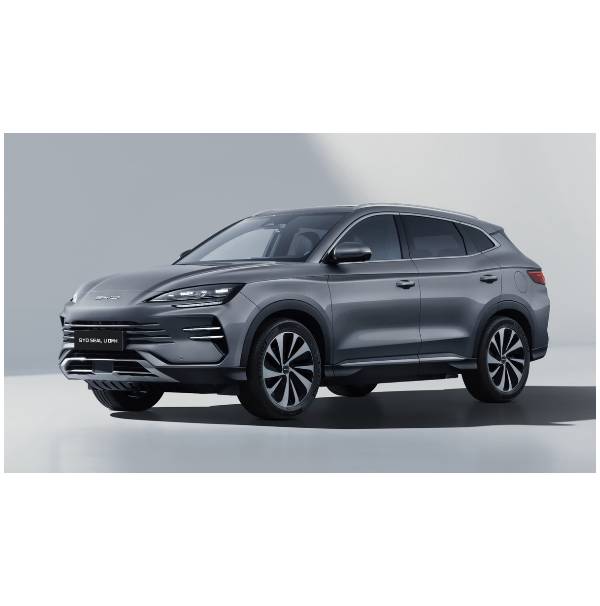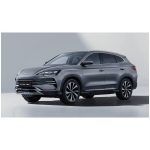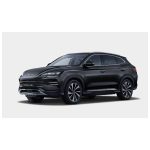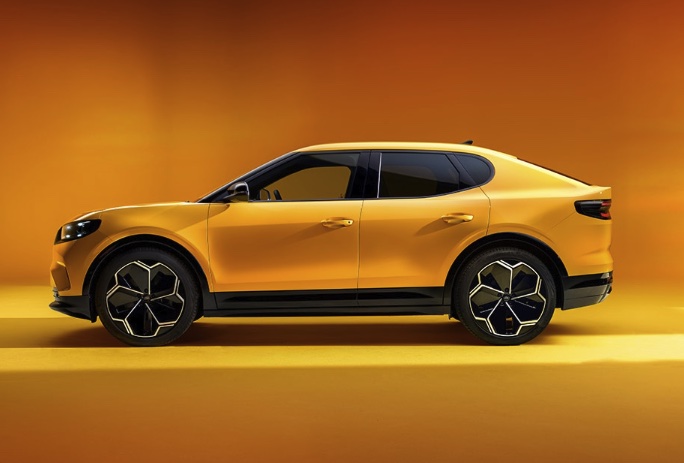Electric Cars: The Basics
For those of you new to zero-emission electric driving, we recommend a read of the following articles:
Sign up to the newsletter
The BYD SEAL U PHEV SUV
BYD Auto Co., Ltd was established in 2003 and is a subsidiary of BYD Company Limited, a publicly listed Chinese conglomerate headquartered in Shenzhen, China. BYD, an acronym for ‘Build Your Dreams’ manufacturers passenger cars, buses, trucks, forklifts, electric bikes and automotive components.
In relation to electric vehicles (EVs), BYD is now the largest EV manufacturer in the world. BYD ended the production of conventional internal combustion engine (ICE) vehicles in 2022, to focus on the development and manufacturer of electric cars. The company currently has the following battery-electric vehicles (BEVs) and plug-in hybrid electric vehicles (PHEVs):
- All-electric BYD Atto 2
- All-electric BYD Atto 3
- All-electric BYD Dolphin
- All-electric BYD Seal
- All-electric BYD Sealion 7
- All-electric BYD Tang
- All-electric BYD Han
- All-electric BYD Seal U
- BYD Seal U DM-i Plug-in Hybrid
The BYD SEAL U SUV (D-segment) has been manufactured since 2020 as part of the BYD SONG SUV series named after the SONG dynasty. The plug-in hybrid variant was launched in China in 2021. Shortly afterwards in 2022 the conventional petrol variant was phased out. The European PHEV variant was introduced in 2024. It is the first BYD PHEV introduced in the European market. To avoid any confusion the other BYD SEAL is an all-electric saloon and not an SUV! There is an all-electric BYD SEAL U SUV currently available in some European markets.
For those keen to migrate to electric vehicles (EVs), but undecided between an all-electric car (pure electric car) or a plug-in hybrid electric car, we at e-zoomed encourage opting for an all-electric car. The availability of pure electric cars across all segments and budgets is excellent, offering style, technology, versatility, practicality, fun and more than adequate real-world zero-tailpipe emission electric range. Though there are many reasons to chose a battery-electric vehicle (BEV) over a plug-in hybrid electric vehicle (PHEV), the two key reasons are: lower life-cycle cost of ownership and lower life-cycle environmental impact (emissions).
Contrary to what is usually suggested, BEVs, also known as all-electric cars/ pure electric cars, are cheaper to own, operate, charge (refill) and maintain over the life of the electric vehicle, compared to plug-in hybrid electric vehicles (PHEVs), and conventional internal combustion engine (ICE) petrol and diesel cars. In stark contrast, conventional petrol and diesel vehicles have the highest cost of ownership of a vehicle.
Moreover, on a life-cycle emission basis, BEVs have far lower emissions compared to PHEVs or conventional petrol and diesel vehicles. BEVs life-cycle emissions are potentially 50% lower compared to conventional petrol or diesel vehicles! And do keep in mind a BEV does not have a tailpipe i.e. zero-tailpipe emissions (improving local air quality). So owning a BEV is both, good for the environment and the household/ business wallet!
Of course, for those still keen on a plug-in electric car, the choice and availability has also increased significantly over the recent years, with PHEVs capable of delivering practical real-world zero-tailpipe emission electric range. The earlier generation of PHEVs had a small (less than 10 kWh) onboard EV battery, with a real-world range less than 30 km.
The BYD SEAL U DM-i plug-in hybrid is a good example of the improved electric range of PHEVs. The SEAL U plug-in electric family SUV uses the BYD developed Super DM (Dual Mode) hybrid technology. Hence the ‘DM-i’ in the model name. The ‘i’ stands for intelligence. According to BYD, the hybrid technology offers a number of benefits, to include: higher energy efficiency and lower fuel consumption.
The SEAL U PHEV is available in two EV battery sizes (cobalt-free (LFP) BYD Blade Battery): the entry-level 18.3 kWh (339.2 V), and the larger 26.6 kWh (339.2 V) variant. According to BYD, the front-wheel drive (FWD) 18.3 kWh variant has a 80 km (WLTP) electric range, while the all-wheel drive (AWD) 18.3 kWh variant has a 70 km (WLTP) e-range. The larger 26.6 kWh (FWD) has a 124 km (WLTP) claimed electric range. The manufacturer claims an electricity consumption between 5.0-5.9 km/kWh. Until and unless you really need an all-wheel drive (AWD) powertrain, we would recommend choosing the 26.6 kWh front-wheel drive (FWD) variant, as it has the longest electric range.
Of course, real-world zero-tailpipe emission electric range will be lower than claimed WLTP range. A number of factors impact e-range, to include: driving style, speed, road surface, vehicle weight, weather, temperature, terrain, tyre size, regenerative braking profile and more! For the 26.6 kWh variant a 105 km range will be more realistic. For the 18.3 kWh variants, expect a real-world range between 60-70 km.
By way of comparison, the Renault Rafale PHEV SUV has a 22 kWh onboard EV battery and a 105 km claimed e-range (WLTP) and the Mazda CX-60 Plug-In Hybrid SUV has a 17.8 kWh EV battery and a 60 km (WLTP) range.
We recommend keeping the plug-in hybrid EV battery charged on a regular basis to leverage the benefits of driving on electric mode. Do keep in mind that when a PHEV is driven on e-mode the tailpipe emissions are zero, further improving local air quality. The BYD SEAL U PHEV has between 15-37g (CO2/km) tailpipe emissions. In comparison, the Renault Rafale E-TECH Plug-In Hybrid has between 12-15g (CO2/km) and the Mazda CX-60 PHEV has up to 33g (CO2/km).
Moreover, driving on electric mode will improve the efficiency of the EV i.e lower fuel costs! If the PHEV is driven primarily using the onboard internal combustion engine (ICE), then the real-world fuel economy will be similar to the conventional petrol variant. So keep topping up the EV battery often to achieve the maximum fuel economy!
The BYD SEAL U SUV PHEV offers 18 kW DC charging capability as standard. Not all PHEVs offer DC charging capability. Depending on the SEAL U variant, the PHEV can be charged from 30%-80% between 35-55 mins. The EV offers 11 kW AC (three-phase) onboard charging as standard. For those with access to three-phase EV charging, the 18.3 kWh variant can be charged 15%-100% in 120 minutes via a dedicated smart residential EV charger. The 26.6 kWh EV battery will take up to 192 mins for a full charge. Single-phase (7 kW) EV charging will take longer.
We encourage the use of a solar compatible smart EV charger, like Hypervolt, along with an on-site PV system and energy storage system. Of course, solar and battery storage can also power your home and further reduce the household energy bills and emissions footprint!
In terms of size, the 5-seat BYD SEAL U PHEV is 4.77m long and 1.67m tall. In comparison, the Renault Rafale PHEV is 4.71m long and 1.61m tall. The Mazda CX-60 PHEV is 4.74m in length and 1.67m in height! The five-door SEAL U PHEV offers 425 L boot space, which increases up to 1,440 L with the seats folded. In comparison, the Renault Rafale PHEV has a 539 L boot and the Mazda CX-60 PHEV has a 570 L boot. The exterior styling is pleasant, but does not stand out. Having said that, the EV styling is a good balance between conventional and futuristic design language. According to BYD, the SEAL PHEV ‘combines oceanic aesthetics with futuristic touches’.
The interior is appointed to a good standard, to include, soft-touch materials. It certainly feels more premium than budget. There is ample headroom and legroom, except for taller passengers seated in the rear, where headroom feels limited. The driver position has good visibility, though the rear-view visibility could be better. In any case, the EV incorporates 360-degree cameras as standard. There is decent internal storage in the cabin. Overall, a spacious feel to cabin, further enhanced by the panoramic sunroof that comes as standard.
The EV offers the following safety features as standard on all variants: parking radars (front and rear), adaptive cruise control, lane keep assistance, blind spot detection, lane change assist, intelligent speed limit control, front cross traffic alert, forward collision warning, lane departure warning, lane departure assistant, traffic sign recognition, indirect driver fatigue management, door opening warning and a lot more. The BYD SEAL U PHEV has been awarded a five-star Euro NCAP Safety Rating. Also as standard are: Vehicle-to-Load (V2L), 15.6″ rotatable touchscreen, 12.3″ TFT full LCD instrument panel, Head-up Display (HUD), smartphone wireless charging, Android Auto, Apple CarPlay and more!
The BYD SEAL U PHEV incorporates a four-cylinder 1.5-litre turbo powered petrol engine. The front-wheel drive (FWD) variant can achieve 0-100 km/h in 8.9 seconds (maximum power: 217 ps/ torque: 300 Nm). The top speed of the PHEV is 169 km/h. The All-wheel drive (AWD) Seal U PHEV variant can achieve 0-100 km/h in 5.9 seconds (maximum power: 323 ps/ torque: 550 Nm). The top speed of the PHEV is 180 km/h. The EV incorporates a number of driving mode, to include: Eco, Normal, Sport, Snow, Sand and Muddy. We encourage using the Eco mode as often as possible!
Is the BYD SEAL U PHEV a good car? The e-SUV has much to offer in terms onboard equipment, quality and practicality. Bottom-line, electric driving is good for the environment and the wallet!
| PROS | CONS |
|---|---|
| Practical real-world electric range | Rear-view visibility could be better |
| Good level of onboard equipment/ technology as standard (V2L/ HUD) | Limited physical buttons in the cabin |
| 18 kW DC/ 11 kW AC (three-phase) EV charging as standard | Rear headroom could be an issue for taller passengers |
The SEAL U DM-i Plug-In Hybrid SUV (credit: BYD)
| At A Glance | |
|---|---|
| EV Type: | Plug-In Hybrid Electric Vehicle (PHEV) |
| Body Type: | SUV |
| Engine: | Petrol-Electric |
| Available In India: | No |
| Variants (1 Option) |
|---|
| BYD SEAL U DM-i (from ₹ N/A) |
| EV Battery & Emissions | |
|---|---|
| EV Battery Type: | Lithium Iron-Phosphate (LFP) |
| EV Battery Capacity: | Available in two battery sizes: 18.3 kWh (339.2 V)/ 26.6 kWh (339.2 V) |
| Charging: | 18 kW DC rapid charging (30%-80%: 35-55 mins). Onboard charger 11 kW AC (15%-100% : 120–192 mins) |
| Charge Port: | Type 2 |
| EV Cable Type: | Type 2 |
| Tailpipe Emissions: | 15-37g (CO2/km) |
| EV Battery Warranty: | 8 years or 160,000 km (70% of the battery’s original capacity) |
| Charging Times (Overview) | |
|---|---|
| Slow charging AC (3 kW – 3.6 kW): | 6 – 12 hours (dependent on size of EV battery & SOC) |
| Fast charging AC (7 kW – 22 kW): | 3 – 8 hours (dependent on size of EV battery & SoC) |
| Rapid charging AC (43 kW): | 0-80%: 20 mins to 60 mins (dependent on size of EV battery & SoC) |
| Rapid charging DC (50 kW+): | 0-80%: 20 mins to 60 mins (dependent on size of EV battery & SoC) |
| Ultra rapid charging DC (150 kW+): | 0-80% : 20 mins to 40 mins (dependent on size of EV battery & SoC) |
| Tesla Supercharger (120 kW – 250 kW): | 0-80%: up to 25 mins (dependent on size of EV battery & SoC) |
- Note 1: SoC: state of charge
| Dimensions | |
|---|---|
| Height (mm): | 1670 |
| Width (mm): | 1890 |
| Length (mm): | 4775 |
| Wheelbase (mm): | 2765 |
| Turning Circle (m): | 11.0 |
| Boot Space (L): | 425 (up to 1,440 L with seats folded) |
| Frunk (L): | N/A |
| BYD Seal Boost | |
|---|---|
| EV Battery Capacity: | 18.3 kWh (339.2 V) |
| Pure Electric Range (WLTP): | 80 km |
| Electric Energy Consumption (km/kWh): | 5.9 |
| Fuel Consumption (L/100 km): | N/A |
| Charging: | 18 kW DC rapid charging (30%-80%: 35 mins). Onboard charger 11 kW AC (15%-100% : 120 mins) |
| Top Speed: | 169 km/h |
| 0-100 km/h: | 8.9 seconds |
| Drive: | Front-wheel drive (FWD) |
| Electric Motor (kW): | 160 |
| Horsepower (ps): | 217 |
| Torque (Nm): | 300 |
| Transmission: | Automatic |
| Seats: | 5 |
| Doors: | 5 |
| Kerb Weight (kg): | 1,940 |
| Towing Capacity (Braked/Unbraked)/ (kg): | N/A |
| Colours: | 4 |
| Euro NCAP Safety Rating: | 5/5 |
| Insurance: | N/A |
| BYD Seal Comfort | |
|---|---|
| EV Battery Capacity: | 26.6 kWh (339.2 V) |
| Pure Electric Range (WLTP): | 124 km |
| Electric Energy Consumption (km/kWh): | 5.6 |
| Fuel Consumption (L/100 km): | N/A |
| Charging: | 18 kW DC rapid charging (30%-80%: 55 mins). Onboard charger 11 kW AC (15%-100% : 192 mins) |
| Top Speed: | 169 km/h |
| 0-100 km/h: | 8.9 seconds |
| Drive: | Front-wheel drive (FWD) |
| Electric Motor (kW): | 160 |
| Horsepower (ps): | 217 |
| Torque (Nm): | 300 |
| Transmission: | Automatic |
| Seats: | 5 |
| Doors: | 5 |
| Kerb Weight (kg): | 1,995 |
| Towing Capacity (Braked/Unbraked)/ (kg): | N/A |
| Colours: | 4 |
| Euro NCAP Safety Rating: | 5/5 |
| Insurance: | N/A |
| BYD Seal Design | |
|---|---|
| EV Battery Capacity: | 18.3 kWh (339.2 V) |
| Pure Electric Range (WLTP): | 70 km |
| Electric Energy Consumption (km/kWh): | 5.0 |
| Fuel Consumption (L/100 km): | N/A |
| Charging: | 18 kW DC rapid charging (30%-80%: 35 mins). Onboard charger 11 kW AC (15%-100% : 120 mins) |
| Top Speed: | 180 km/h |
| 0-100 km/h: | 5.9 seconds |
| Drive: | All-wheel drive (AWD) |
| Electric Motor (kW): | 238 |
| Horsepower (ps): | 323 |
| Torque (Nm): | 550 |
| Transmission: | Automatic |
| Seats: | 5 |
| Doors: | 5 |
| Kerb Weight (kg): | 2,100 |
| Towing Capacity (Braked/Unbraked)/ (kg): | N/A |
| Colours: | 4 |
| Euro NCAP Safety Rating: | 5/5 |
| Insurance: | N/A |
Top Reasons To Buy An Electric Vehicle (EV)
Never have the reasons to buy an electric car been more compelling, than today. The past decade has witnessed a significant maturity of all types of electric vehicles (EVs), to include, battery-electric vehicles (BEVs) and plug-in hybrid electric vehicles (PHEVs). A BEV, also known as a pure electric car, is propelled using energy stored in an EV battery via an electric motor. While a PHEV uses ‘hybrid technology’, to include, an internal combustion engine (ICE) and an electric motor, to propel the vehicle.
One of the primary differences between a BEV and a PHEV, is that, a pure electric car, like the best-selling Tesla Model 3, has a much longer zero-tailpipe emission electric range, compared to a plug-in hybrid electric car, like the Toyota Prius PHEV. The reason is simple: a BEV has a much larger onboard EV battery. In general, the latest BEVs have a zero-emission range between 150 to 600 km on a single charge, while PHEVs average between 50-75 km. Given the significant increase in electric range, improvement in EV charging infrastructure and attractive government grants, BEVs are fast becoming the preferred type of electric vehicle to own!
In India, we have also witnessed an increase in the availability of pure electric cars. Some of these include: the all-electric BMW i7, the all-electric Kia EV6, the all-electric BMW iX, the all-electric BYD ATTO 3 and many more! Expect this momentum to increase significantly, as more EV automotive manufacturers cast an eye on the Indian automotive market!
| Top Reasons To Buy An Electric Vehicle (EV) |
|---|
| Lower tailpipe emissions and lower air pollution i.e. improves air quality in the immediate area. A pure electric car (BEV) has zero-tailpipe emissions! |
| Significantly cheaper to recharge a full EV battery, compared to filling a full tank of petrol/ diesel. |
| Cheaper to drive per km, compared to an internal combustion engine petrol/ diesel car. |
| Lower maintenance costs, compared to aninternal combustion engine petrol/ diesel car. Pure electric cars have fewer moving parts, so less can go wrong! |
| Lower noise pollution,compared to aninternal combustion engine petrol/ diesel car. Noise pollution is as detrimental on health, as air pollution! |
| A vast range of fantastic EV available on sale, for all budgets and aspirations. EVs have come a long way since the introduction of the first generation all-electric Nissan Leaf in 2010. |
| Attractive government subsidies to support the uptake of electric cars. Take advantage while still available. |
| Lower life-cycle emissions compared to conventional petrol and diesel cars. EVs are far better for the environment! |
While e-zoomed uses reasonable efforts to provide accurate and up-to-date information, some of the information provided is gathered from third parties and has not been independently verified by e-zoomed. While the information from the third party sources is believed to be reliable, no warranty, express or implied, is made by e-zoomed regarding the accuracy, adequacy, completeness, legality, reliability or usefulness of any information. This disclaimer applies to both isolated and aggregate uses of this information.
































